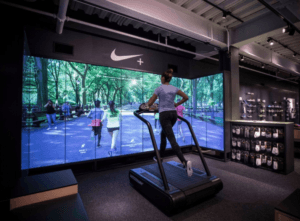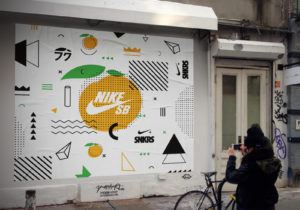Retail is(n’t) dead (for all) – Nike is Just Doing It

Nike is bucking the "retail is dead" trend by integrating digital disruptions into their strategy and effectively meshing the offline and online worlds through experiences such as Nike Soho.
“Retail is dead” – how many times have we all read this headline. But retail isn’t necessarily dead. Yes, retail as we have historically thought of it is dead, but for those retailers who have been able to adapt to and integrate digital technologies into their current strategies are bucking this trend.
Amazon’s undeniable dominance across so many retail verticals, along with the emergence of start-ups capitalizing on direct-to-consumer, online-only models, are putting undeniable pressure on traditional retail models, as their long-established economics and operating models just can’t compete with new entrants’. The numbers speak for themselves – in 2017, there were an estimated 9,452 store closings, which is 53% more than there were during 2008’s Great Recession.[1]
While many retailers’ doors are shuttering from this pressure, we’ve also seen an interesting trend towards increasing brick and mortar presence. In fact, retailers such as Warby Parker, M. Gemi, Bonobos, and even Amazon, have all migrated from online-only models to establishing physical footprints. What’s important to differentiate is that these retailers are building offline presences in new ways, ways that emphasize what experts refer to as “experiential retail — creating destinations for customers that go way beyond the act of purchase and immerse customers in a 360-degree brand lifestyle.”[2]
The retailers that continue to excel in this rapidly changing retail environment will be those able to mesh the online, digital world with the offline world. Unifying these worlds however, is complicated – consumers’ actions, such as browsing products and adding items to a bag, suddenly become a black box when taken offline. Brands that can identify customers offline and can personalize experiences based on their existing knowledge of the customer will ultimately deliver stronger experiences.
Lastly, but perhaps most importantly, retailers must find a way to convert these offline experiences and relationship building tactics into sales.
One company that has ridden this digital wave particularly well and has made considerable efforts across all three of these areas is Nike, positioning them to both create and capture value in this new environment.
Create experiences that engage customers with the brand

Nike’s latest innovation is Nike Soho – Nike’s new 5-story flagship store opened in NYC in November 2017. According to Nike’s press release, the store offers each individual a “personal sport experience,”[3] regardless of the type of athlete you are.
The experiences offered are broad and diverse – ranging from a full basketball court “trial zone” with cameras at multiple angles to record the action, to gait analyses conducted by staff as you run surrounded by screens recreating races.
For its sneaker addicts, Nike has also experimented with its SNKRS app. Geo-targeted campaigns where users can purchase exclusive sneakers from the app, only after traveling to certain locations to unlock secret codes, keep these consumers engaged.
Connect online customer data with these “black box” offline experiences
According to Nike’s press release of Nike Soho, “the store creates a seamless link between Nike’s digital and physical platforms,” and appears to be solving this enduring challenge. Nike actively cultivates its community through its suite of free apps – Nike Run Club, Nike Training Club, SNKRS, and Nike+ Fuel – and can lean on its installed user base here to help track and identify customers as they engage with Nike offline. Even when customers leave the store without making a purchase, the experience is still captured and enriches Nike’s understanding of the customer, which undoubtedly deepens the relationship with the consumer and may accelerate future purchases, regardless of the platform they may occur on.
Convert offline customer relationships and experiences into sales
And while, as a consumer, in many of these experiences you’re likely focused on the experiences themselves rather than sales, Nike I guarantee you is. Whether or not customers are transacting during these offline experiences, Nike has confidence that the investment in retail experiences will eventually lead to increased sales. Now, a lot of this hinges on Nike’s ability to convert additional customer data into incremental value in future touchpoints, but this remains to be proven. However, already Nike has pointed to the fact that customers who use personal shopping appointments transact at three times the average transaction size.[4]
However, while Nike’s progress has been impressive, Nike Soho represents just one (massive) store. What remains to be seen is whether Nike can continue to create these experiences in repeatable, perhaps smaller-scale ways.
Sources:
[1] Clark, Evan, and Evan Clark. 2018. “Which Retailers Are Closing Stores In 2017”. WWD. http://wwd.com/business-news/financial/retail-store-closures-2017-macys-bcbg-american-apparel-wet-seal-abercrombie-limted-jc-penney-sears-10842214/.
[2] Hindman, Ben. 2018. “Retail Is Dead, Long Live The Retail Experience”. Mashable. https://mashable.com/2017/10/24/retail-technology-arms-race-experience-ben-hindman/#12ftS7uKPsqW.
[3] “First Look: Inside Nike Soho”. 2018. Nike News. https://news.nike.com/news/nike-soho-first-look.
[4] “Nike Quarterly Earnings Call Transcript”. 2018. Nike.Com. http://s1.q4cdn.com/806093406/files/doc_financials/2017/Q3/NIKE-Inc.Q317-OFFICIAL-Transcript-with-QA-FINAL.pdf.
References
Clark, Evan, and Evan Clark. 2018. “Which Retailers Are Closing Stores In 2017”. WWD. http://wwd.com/business-news/financial/retail-store-closures-2017-macys-bcbg-american-apparel-wet-seal-abercrombie-limted-jc-penney-sears-10842214/.
“First Look: Inside Nike Soho”. 2018. Nike News. https://news.nike.com/news/nike-soho-first-look.
Ha, Anthony. 2018. “Nike Is Using Its New Digital Studio To Build A Community Of Sneakerheads”. Techcrunch. https://techcrunch.com/2017/10/20/nike-is-using-its-new-digital-studio-to-build-a-community-of-sneakerheads/.
Hindman, Ben. 2018. “Retail Is Dead, Long Live The Retail Experience”. Mashable. https://mashable.com/2017/10/24/retail-technology-arms-race-experience-ben-hindman/#12ftS7uKPsqW.
Kulp, Patrick. 2018. “The Stores Of The Future Will Be Full Of Wine, Yoga, And Not Much Else”. Mashable. https://mashable.com/2017/09/13/retail-stores-of-the-future-sell-nothing/#dRch08_mKOqN.
“Nike Quarterly Earnings Call Transcript”. 2018. Nike.Com. http://s1.q4cdn.com/806093406/files/doc_financials/2017/Q3/NIKE-Inc.Q317-OFFICIAL-Transcript-with-QA-FINAL.pdf.
“Nike’s New Flagship Is A Powerhouse Of Experience-Driven Retail”. 2018. Future Stores Seattle 2018. https://futurestores.wbresearch.com/nike-new-flagship-powerhouse-experience-driven-retail-ty-u.





As an ex-Nike employee, I have always admired the culture that they have built around their brand and thus the associated experience that comes through their in-store engagements (the “if you have a body you are an athlete” experience). It was particularly interesting to learn about Nike’s strategy and its ability to maintain and improve its retail operations and customer experience.I am curious to see how much more innovative Nike will embark on to increase in-store sales. While NikeFuelband was an ultimate failure, the consumer data made available through its app could prove useful in terms of targeted sales and customized/individualized in-store experience.
Thanks for the post! As another ex-Nike employee, an important factor in their digital retail success will be their ability to fulfill orders received through a variety of platforms (online and offline) through multiple distribution points (online and offline). The dream of buy online, pick up in store is now a reality – and Nike must upgrade its infrastructure to do so. Over the summer I looked into ways of doing this, with RFID being a leading technology. Nike’s near-field communication technology present in the latest NBA jerseys can also play a role. In order for them to beat Amazon and other retailers in experiential retail they must ensure full inventory at multiple points – for which I believe they have a long way to go.
Interesting read! I think most retailers these days are attempting to move into experiential retailing that breeds engagement and loyalty. However, as you mentioned, Nike Soho, perhaps the most salient of Nike’s experiential efforts, is only one store. How do you think about the ability of competitors, primarily adidas, to offer a similar or even better in-store experience? Is there a secret sauce behind the success of the Soho store or would competitors find similar success with the same format?